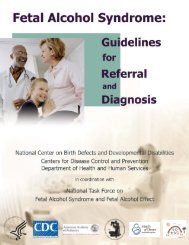FETAL ALCOHOL SPECTRUM DISORDERS florida resource guide
FETAL ALCOHOL SPECTRUM DISORDERS florida resource guide
FETAL ALCOHOL SPECTRUM DISORDERS florida resource guide
- No tags were found...
You also want an ePaper? Increase the reach of your titles
YUMPU automatically turns print PDFs into web optimized ePapers that Google loves.
SECTION 6PreventionCurrent Strategies, continuedThe cadre of universal prevention methods have been somewhateffective in increasing the general public’s knowledge about thedangers of drinking while pregnant. Studies on awareness of thealcohol beverage warning label showed an increase in awareness overtime. And, a larger proportion of the public is knowledgeable aboutthe relationship between drinking during pregnancy and FAS(Hankin, 2002).Selective prevention methods target women of childbearing age whodrink alcohol. Screening all women who are pregnant for alcohol useis one example of a selective prevention method.An example of selective prevention is the CDC’s project CHOICES.This project is working to prevent FASD by educating women aboutthe risk of prenatal alcohol exposure before they become pregnant.Indicated prevention methods are directed at high-risk women,including women have previously delivered an infant with FAS orFAE. Indicated prevention methods have shown substantial progressin preventing prenatal alcohol exposure. The following studiesdemonstrate the effectiveness of indicated prevention methods.For more information on the CDC’s project CHOICES: www.cdc.gov/ncbddd/fas/choices.htmIn a study of 42 women who reported drinking while pregnant, 34showed a significant reduction in alcohol consumption two monthsafter receiving either written information about the risks related todrinking during pregnancy or a one-hour motivational interviewfocusing on the health of the participants’ unborn babies (Handmaker,Miller, & Manicke, 1999).In another study, 123 pregnant women received a brief interventionafter a comprehensive alcohol assessment was completed shortly afterinitiating prenatal care. Seventy-seven percent of the women choseabstinence during pregnancy as their goal during the briefintervention; twenty-three percent did not choose to be abstinent forvarious reasons (Chang, Goetz, Wilkins-Haug, & Berman, 2000).Through a local referendum, a community in Alaska prohibited thepossession of alcohol in an attempt to reduce prenatal alcoholexposure. The self-reported alcohol use among pregnant womenduring the initial six-month period of the alcohol ban (November1994 through March 1995) was compared with that of a similar groupof women prior to the ban. During the first five months of the ban,alcohol abuse during pregnancy dropped significantly from 42% to9% (Bowerman, 1997).46 <strong>FETAL</strong> <strong>ALCOHOL</strong> <strong>SPECTRUM</strong> <strong>DISORDERS</strong> <strong>florida</strong> <strong>resource</strong> <strong>guide</strong>



